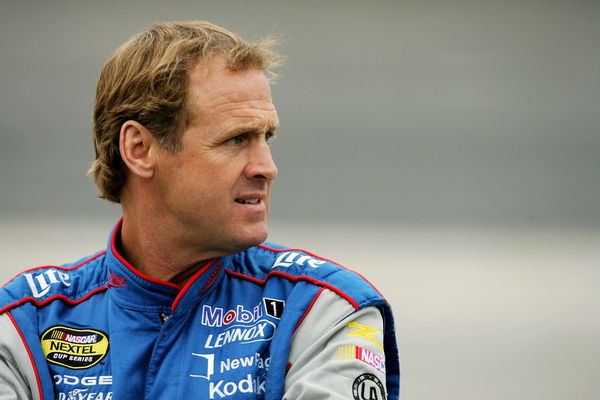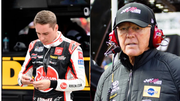
via Getty
MARTINSVILLE, VA – OCTOBER 21: Rusty Wallace, driver of the #2 Miller Lite Dodge, looks on during NASCAR Nextel Cup Subway 500 Qualifying on October 21, 2005 at Martinsville Speedway in Martinsville, Virginia. (Photo by Streeter Lecka/Getty Images)

via Getty
MARTINSVILLE, VA – OCTOBER 21: Rusty Wallace, driver of the #2 Miller Lite Dodge, looks on during NASCAR Nextel Cup Subway 500 Qualifying on October 21, 2005 at Martinsville Speedway in Martinsville, Virginia. (Photo by Streeter Lecka/Getty Images)
NASCAR is back on a short track this weekend. And it looks like the Cook Out 400 at Richmond Raceway is sure to ensure an exciting return to racing after two long weeks. To make sure teams get to experiment with even more strategic decisions, tire partners Goodyear is bringing two separate sets of slicks to Sunday’s Cup race. NASCAR even updated its rulebook during this Olympic break. And if all runs well, we just might come one step closer to the Gen 7 car’s true potential with this very outing.
Although a lot of that sentiment is highly speculative, Richmond’s winningest driver, on its widely scrutinized three-quarter-mile surface, recently made an interesting point about NASCAR’s Next-Gen brand of racing. If you didn’t know by now, that man is 1989 Winston Cup champion, Rusty Wallace. In a recent episode of the ‘Kenny Conversations’, he caught up with his popular brother Kenny. And in their discussions, the 6-time Richmond winner expressed his full support towards the sport’s big equalizer.
ADVERTISEMENT
Article continues below this ad
Rusty Wallace loves the parity of the Next-Gen car, but is everyone sold?
These days, the discussion of parity draws the attention of many. After all, with a field that turns tighter by the weekend, it is only normal to notice the huge outlier in the past three years since the Gen 7 debuted in NASCAR. No single driver has dominated the others the way they used to back when icons like Rusty Wallace were still active. Gone are the times when the leader would be at least 10 laps ahead of the car running in P10 at Talladega. The distance between these new Chevys, Fords, and Toyotas only gets shorter by the millisecond with every race weekend.
It has been even more uncommon to see a driver win 10 races in this Next-Gen era as Rusty did back in 1993 (his career best) when he finished second to Dale Earnhardt, who won his 6th series championship with 6 races that season. In fact, the last person to win 10 races in a year was Kyle Larson in 2021. And that was the last time NASCAR ran the Gen-6 car in competition before the Next-Gen debuted in 2022. Rusty Wallace notices all this from the sidelines. At 67, the proud recipient of multiple Hall of Fame inductions, who owns at least ten car dealerships in Tennessee, has an observant eye.
When his brother asked him how he felt about this version of the Next-Gen car, Rusty answered with an expert lens, “Well, seriously… I had question marks about the car but I do like the car. One thing I do like about the car is that it has really made a lot of drivers able to show their talents.” He singled out the all-important factor affecting these Next-Gen races, when he said, “There’s drivers out there that are really running up front that I personally thought were good drivers but average drivers, that weren’t running up front on a consistent basis. And now these guys with this new car are upfront every single week, and they’re able to show their talent. The cars are so identical it’s unreal, really.”
“Kenny Conversation”
Checking in with Rusty Wallace 🏁
1- @ItsBristolBaby baseball game.
2- Rusty’s most influential people that helped him.
3- @NASCAR today. pic.twitter.com/i1GEat9Bcb— Kenny Wallace (@Kenny_Wallace) August 9, 2024
The 55-time Cup race winner then observed “the difference,” which he noted were the variables like “the pit crew, the strategy, the small amount of setups in the car,” etc. However, he concluded on quite a positive note since “the horsepower is almost identical. The body shape is identical, all the rules are identical. And because of that, it’s let teams that maybe weren’t the greatest teams run with the good teams.” Rusty highlights this as the aspect that he enjoys the most about these Gen 7 vehicles.
When we’re talking NASCAR cars, very few hold the level of expertise that is in the hands of Rusty Wallace. The man raced at least 750 times across the top-3 national touring series over a 25-plus-year timeframe. In that time, he became the winningest driver for Pontiac with 31 race wins, a now-obsolete manufacturer that dominated NASCAR racing during its earlier days. Although Rusty’s observations and reasoning are spot on toward the current state of things in stock car racing, many could argue that there is still a top-heavy dynamic that caters to the bigger teams like Hendrick Motorsports and Joe Gibbs Racing. After all, drivers from either of those teams have won 17 of the last 22 races in the 2024 Cup season.
Many more argue that putting all the reigns in the hands of only three manufacturers limits the options for additional evolution with an emphasis on a lack of integrity in equity. Regardless, NASCAR is switching up things almost every weekend to unlock the Gen 7’s full potential, which is still stuck in its experimental phases. A closer look at the major changes this weekend would shed light on the bigger picture that NASCAR envisions.
ADVERTISEMENT
Article continues below this ad
Trending
New rules shake-up pit road strategy at Richmond
Heading into this week, the big one on the surface at Richmond is the introduction of the new ‘option’ tires at the Cook Out 400. Essentially, these tires stand to wear out faster and offer more grip than the standard 18-inch ‘prime’ radials we see normally. The ‘options’ were last used in competition at the All-Star race in North Wilkesboro, promising a fresh respite on its surface. However, once they wore down, cars running these newer compounds were about as fast as those running fresher prime tires. It is important to note that Richmond II at night offers a much more abrasive surface than North Wilkesboro, and the amount of tire fall-off on hand for teams at the racetrack has been quite extreme in the past. In simple words, tires wear out quicker at Richmond, making it a proper single-file “chess match” between crew chiefs.
Back in March, it was Chris Gabehart and the #11 crew outsmarted the rest of the field with a little help from a controversial restart where Denny Hamlin faced accusations of a bunny-hop on his teammate Martin Truex Jr. That received a lot of outrage, but every little advantage counts on a track like Richmond, which is at risk of losing its second date with the release of the 2025 schedule. Drivers have been vocal about the lack of passing on its aging surface in recent years, even more so, with the Next-Gen car in the current picture.
ADVERTISEMENT
Article continues below this ad
But when rains historically forced NASCAR teams to start the Toyota Owners 400 debuting Goodyear’s wet weather tires, for those 30 laps the competition felt just a little different that Sunday. It all changed when the governing body decided that teams were to switch back to slicks after Lap 32, which then put forth a race that was more characteristic of a Richmond outing. The verdict was this: for all the talk of parity, Mother Nature appeared to be the only one properly equipped to make Richmond “the Action Track” again. Hence, this weekend, NASCAR has decided that they will no longer dictate when a car can change tires under caution in rainy conditions. Teams can also stay out during yellow flag conditions, bringing in another dimension for the pit road strategies in play.
Conversely, NASCAR will still be able to decide when teams change back to slicks. So that leaves a crucial point of contention in the questions, yet again. Regardless, with Tropical Storm Debby threatening rains over Virginia this weekend, could wet weather help us witness a new brand of short-track racing with this Next-Gen car for the very first time? Let us know your thoughts in the comments below
ADVERTISEMENT
ADVERTISEMENT
ADVERTISEMENT
ADVERTISEMENT






